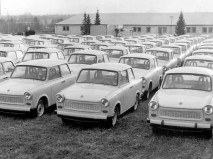1964 Trabant 601
With hindsight it can be considered East Germany's response to West Germany's 'Peoples Car', the VW Beetle. Its purpose was to provide a cheap but still reliable car that was very affordable and also easy to repair and maintain. Still, it was at the time of its release rather modern in many ways, with front wheel drive, a low maintenance engine, unitary construction, composite bodywork and independent suspension all around. The main letdown was the pre-war DKW based engine that was competitive when launched, but from the late 1950s into the 1960s, small economy cars in western countries that used two-stroke engines, were replaced with cleaner and more efficient four-stroke engines, as employed from the start in the Volkswagen Beetle. Two-stroke engines of this sort, with crankcase scavenging and lubricating oil provided during fuel intake, burn their lubricating oil by design and produce smoky tailpipe emissions. However, two-stroke engines were also to be found in cars like the Western German Auto Union 1000 that ended production in 1963, and the Swedish Saab 96 that changed to four-stroke in 1967. The lack of development funds in East Germany forced the continued use of a two-stroke engine in the Trabant, thus causing this vehicle to become obsolescent in the 1960s and embarrassingly obsolete by the 1980s.
Variants:
• Trabant 601 Standard (as Limousine & Universal).
• Trabant 601 S (Sonderwunsch - Special Edition) With optional equipment like fog lamps, rear white light and an odometer (as Limousine & Universal).
• Trabant 601 DeLuxe. Like the 601 S and additional twin-tone colouring and chrome bumper (as Limousine & Universal).
• Trabant 601 Kübel (added in 1966). Jeep version with no doors, folding roof, auxiliary heating system, ignition system is RFI shielded.
• Trabant 601 TRAMP (added in 1978). Civilian version of the Trabant Kübel, mainly export to Greece.
• Trabant 601 Hycomat (P601 H), 1965–1990, in limited numbers (as Limousine & Universal). Made only for users with missing or dysfunctional left leg. It had included an automatic clutching system.
• Trabant 800 RS. Rally version (1986–1988) with 771 cm³ engine and 5-speed manual transmission.












